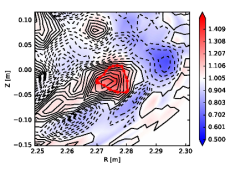The Blob that Ate the Tokamak
Simulations Show How Bubbles at Plasma Edge Drain Heat, Reduce Fusion Reaction Efficiency
January 11, 2018

Normalized density at a single poloidal plane, in color (scale indicated in the colorbar), with fluctuating potential contour lines overlaid to show positive potential (solid black) and negative potential (dashed black) . A detected blob is outlined in the thick red contour line.
To fuse hydrogen atoms into helium, doughnut-shaped devices called tokamaks must maintain the heat of the ultrahot plasma they control. But like boiling water, plasma has blobs, or bubbles, that percolate within the plasma edge, reducing the performance of the plasma by taking away heat that sustains the fusion reactions.
Now, scientists at the U.S. Department of Energy’s (DOE) Princeton Plasma Physics Laboratory (PPPL) have completed new simulations that could provide insight into how blobs at the plasma edge behave. The simulations, produced by a code called XGC1 developed by a national team based at PPPL, performed kinetic simulations of two different regions of the plasma edge simultaneously. This ability produces a more fundamental and fuller picture of how heat moves from plasma to the walls, potentially causing damage.
“In simulations, we often separate two areas at the plasma edge known as the pedestal and the scrape-off layer and focus on one or the other,” said PPPL physicist Michael Churchill, lead author of a paper describing the results in the journal Plasma Physics and Controlled Fusion. “XGC1 is unique because it is able to simulate both regions simultaneously, using kinetic ion and electron equations. In fact, it is important to include both regions in simulations because they affect each other.”
The simulations for this study were done on the Titan system at the Oak Ridge Leadership Computing Facility, while the data analysis was done on the Edison supercomputer at the National Energy Research Scientific Computing Center (NERSC). According to co-author C.S. Chang, terabytes of simulation data were moved to NERSC for analysis and visualization. "NERSC has an ideal software environment for large-scale data analysis," he said.
Toward a Better Understanding of Turbulence
Simulations allow scientists to explore plasma, the fourth and hottest state of matter in which electrons are separated from atomic nuclei, without running physical experiments that could be costly. They also sometimes provide insights that physical experiments do not. Simulations of turbulence at the edge of the plasma, near where the plasma approaches a tokamak’s interior wall, are particularly important. The more that scientists understand such turbulence, the better able they will be to prevent moving blobs of plasma from forming in the plasma edge. If not controlled, these blobs could drain large amounts of heat from the confined plasma, and possibly either damage plasma-facing components or hinder the fusion reactions.
The XGC1 code simulated plasma in high-confinement mode, or H-mode, a set of conditions that helps plasma retain its heat. In H-mode, the results showed, a large number of blobs form between the pedestal and the scrape-off layer, two conditions near the edge, and move towards the outer edge, crossing the magnetic field lines as they go.
Blobs play an important role in the outward movement of particles in plasma. Blobs cause approximately 50 percent of the particle loss at the plasma edge, and researchers have observed blobs in a wide range of plasma devices, including tokamaks, figure-eight-shaped fusion devices known as stellarators, and linear machines. “The big picture is that blobs can pull energy and particles out of the plasma, and you don’t want that,” Churchill said. “You want to keep things confined.”
Future research will focus on how the blobs form and how their behavior is affected by the shape of the tokamak. Scientists must also fully determine how density, temperature, and electromagnetic force affect the behavior of the blobs.
See the original PPPL press release.
About NERSC and Berkeley Lab
The National Energy Research Scientific Computing Center (NERSC) is a U.S. Department of Energy Office of Science User Facility that serves as the primary high performance computing center for scientific research sponsored by the Office of Science. Located at Lawrence Berkeley National Laboratory, NERSC serves almost 10,000 scientists at national laboratories and universities researching a wide range of problems in climate, fusion energy, materials science, physics, chemistry, computational biology, and other disciplines. Berkeley Lab is a DOE national laboratory located in Berkeley, California. It conducts unclassified scientific research and is managed by the University of California for the U.S. Department of Energy. »Learn more about computing sciences at Berkeley Lab.







